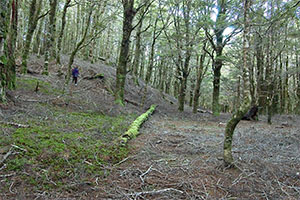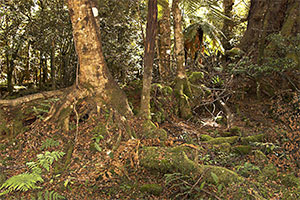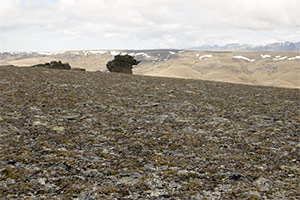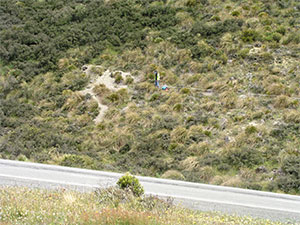|
New Zealand Soil
Fauna
 Native podocarp forest of the South Island, one of the few
remnants.
The soil and leaf litter make up a unique habitat that supports a rich and diverse life. The soil is a matrix of myriad solid mineral particles, decomposing organic matter, and pores filled by water and air. The soil atmosphere is always very humid. Temperature and moisture extremes are attenuated in the soil.
Soil and litter animals avoid light and many of them have poor vision, using instead the senses of touch and smell. Most soil animals absorb and lose water freely through their skin, and so depend on water-saturated atmosphere for their existence. If the soil dries out, the animals migrate away from unfavourable conditions, or persist as resistant eggs. Soil animals play a major role in the breakdown of wood and dead leaves, recycling of nutrients back into the soil, and the release of nutrients to plants. Digging into the soil, soil invertebrates mix together organic and mineral matter, and improve soil aeration, structure, and fertility.
 Southern beech forest, South Island of New Zealand. Unlike temperate and boreal forests of the Northern Hemisphere, New Zealand forests are structured more like the rainforests of the tropics, with their suspended gardens of epiphytes, damp climate, and evergreen vegetation. Wherever organic matter accumulates - in leaf litter on the ground, in the clumps of epiphytes in the canopy, or on mossy tree trunks, soil animals can be found. Decaying logs and dead tree branches provide another important habitat on the forest floor. The characteristics of the soils, the form of the landscape, the vegetation and the history of disturbance all have considerable influences on the soil fauna, its biodiversity, species composition, and the distribution of species in space and time.

Mixed beech/podocarp forest, North Island. |
 Alpine scree, South Island. |
“New Zealand has a relatively small number of indigenous
flowering plants and vertebrate animals by tropical or continental
standards. This is partly because our isolation from continental
landmasses limited large-scale recolonisation by these groups
after the global extinction catastrophe of 65 million years
ago. It is also partly the result of a long period of submergence
between 60 million and 30 million years ago, when up to four-fifths
of the landmass sank below sea level, leaving just a few islands
(Cooper and Milliner, 1993). The ice ages of the past two
million years also had an effect, reducing habitat and fragmenting
populations into ecological 'islands'.
These factors limited the number of major plant and animal
groups in New Zealand, but they also contributed to the uniqueness
of the surviving groups. Cut off from the rest of the world,
evolution took an eccentric course here, leading to a high
percentage of endemic, or unique, species. This high rate
of endemism is what makes New Zealand's biodiversity both
special and highly vulnerable.”
The long-term geographical isolation of New Zealand contributed
to its unique and diverse soil fauna. Colourful flatworms
(phylum Platyhelminthes), slugs and snails of all sizes (phylum
Mollusca), and numerous crustaceans, insects, spiders, myriapods
and mites (all members of the phylum Arthropoda) make up the
populations of New Zealand soils. Some exotic animals include
giant blue springtails (Holacanthella spp, phylum Arthropoda,
class Collembola), giant bioluminescent native earthworms
(Megascolecidae, phylum Annelida), and the living fossil –
the peripatus (phylum Onychophora).
From: The State of New Zealand’s Environment 1997, published by The NZ Ministry for the Environment and GP Publications, Wellington, New Zealand. Click here to read The State of NZ Environment 1997 online.
On
giant New Zealand invertebrates:
|
Box 9.4: Jurassic giants
Gigantism evolved in various groups of New Zealand
animals (Daugherty et al., 1993). The giant birds, such
as Haast's eagle and the moas, are extinct but many
invertebrate giants still hang on in the face of rat
predation and habitat destruction. Most are confined
to isolated locations or rat-free islands (Meads, 1990).
The world's heaviest insect is among them - the giant
wingless cricket, or weta, of Little Barrier Island.
At lengths of more than 8 cm and weights of up to 70
g, this relative of primitive grasshoppers is as heavy
as 4 or 5 mice. Known to Maori as the wetapunga or 'god
of ugly things', it is the largest of our dozen giant
weta species (Deinacrida spp.). It has a docile
temperament and lives high in the tree tops. In Jurassic
times, 190 million years ago, giant wetas were widespread
around the world. Now New Zealand is their only holdout.
While all seven species of the smaller tree weta (Hemideina
spp.) are quite common, the giants face an uncertain
future. All but one, the alpine scree weta (D. connectans)
of the South Island mountains, are listed as threatened.
Another group of wingless crickets, the large elephant
or tusked wetas, is also under extreme threat. Named
for their 2 cm tusks, these wetas can grow up to 8 cm
long and live in ground burrows. Three species have
been discovered. One is confined to a few hectares of
forest on Middle Mercury Island, near the Coromandel
peninsula, one is scattered in parts of Northland and
one was recently discovered in the Raukumara mountains
in Bay of Plenty.
Myriapods (millipedes and centipedes) are a less flamboyant
class of arthropods than the insects, but they also
have monsters, such as the giant pill millipede (Procyliosoma
tuberculata). Unlike its smaller relatives in Europe,
which were swallowed as folk medicine, this pill would
be hard to wash down with a glass of water. Females
can grow up to 5 cm long and 2.5 cm wide. They feed
on rotting leaves and are widespread in the North Island
and northern South Island. They reach full size, however,
only on rat-free islands. Then there is the giant centipede
(Cormocephalus rubriceps) which, at 25 cm,
looks like the caterpillar from Hell with its armour-plating
and jointed legs. However, mothers are protective of
their young, even carrying them around. They capture
prey (usually insects, spiders, snails and slugs) with
claw-tipped pincers which inject a lethal poison. They
can even kill small lizards. Though still present in
the North Island, full-sized ones are only found on
rat-free islands (Meads, 1990).
Spiders belong to the third class of land arthropods,
the Arachnids. Our largest, the Cave spider (Spelungula
cavernicola), may be a 'missing link' between primitive
spiders, which arose 350 million years ago, and the
modern 'true' spiders. Its 3 cm body and 30 cm leg-span
have startled more than one speleologist in the limestone
caves of the Tasman Region where it lives. It is very
rare and is the only spider protected by the Wildlife
Act 1953 (Faulls, 1991). Another group of indigenous
giants confined to the Tasman Region are the giant red
flatworms (Geoplana spp.), which can reach lengths of
20 cm. They hunt by smothering their victims (mainly
slugs and snails) in slimy mucus. Once abundant, they
are rarely seen today.
Far more widespread are the nine species of giant
land snail (Powelliphanta spp.) whose colourful
shells can be up to 10 cm in diameter. Some of these
snails have human-scale lifespans, taking up to 15 years
to reach maturity and living 40 years or more. Their
reproductive rates are correspondingly low. The giant
snails belong to the oldest family of carnivorous land
snails on earth, having originated about 200 million
years ago. They prey mainly on earthworms, slugs and
other snails. Although they are scattered across habitats
ranging from forest to alpine grassland, they have been
driven into confined areas and nearly all are listed
as threatened. Related to the giant snails are the giant
leaf-veined slugs (Pseudaneitea gigantea) which,
at 15 cm, are the largest of our native slugs. These
have also been driven into relic areas of forest and
tussock grassland.
From: The State of New Zealand’s Environment 1997, published by The NZ Ministry for the Environment and GP Publications, Wellington, New Zealand. Click here to read The State of NZ Environment 1997 online. |
Conserving Soil Biodiversity in New Zealand

Alpine grassland of Canterbury, South Island.
The New Zealand landscapes, once largely covered in forest, have been extensively altered by human activity. Two-thirds of New Zealand forests have been cleared, and the land is now used for intensively managed cropland and pasture grassland. Many species of the original forest soil fauna did not survive land conversion and disappeared from agricultural ecosystems. In return, many introduced soil species have become established in New Zealand, replacing the indigenous soil fauna in human-modified environments. Today, most of the common soil animals found in farmland, urban parks and suburban gardens are introduced species. If you do not know whether the soil animal you found is native or introduced, as a rule, a species found in undisturbed land well away from human habitation is probably native, whereas one found in a garden or a city park is most likely introduced. There are many exceptions – some truly native species have invaded agricultural systems and urban environments over the last 150 years, and in some areas introduced species have invaded forest and alpine soil ecosystems.
Little is known of the requirements for the survival and
health of New Zealand’s endemic invertebrate fauna.
The clear-cut of the forest and the conversion of woodlands
into farmlands may have contributed to the loss of soil biodiversity.
To a lesser degree, the removal of dead trees from paddocks
eliminates important habitats for soil invertebrates. We
have limited knowledge of the extent to which native soil
biota is able to survive in small isolated remnants of native
bush within agricultural areas. There is evidence, however,
that indigenous soil fauna can persist cryptically in small
patches of native vegetation even in urban environments. Introduced to New Zealand ground-dwelling mammals pose another
major threat to indigenous soil fauna (the endemic vertebrate
fauna of New Zealand consisted of birds, bats and reptiles
only). Introduced by humans – possums, stoats, pigs, rats and
mice routinely prey on soil invertebrates, while larger mammals
such as deer and goats change or destroy the habitat and food
sources of native species. Rats and mice, which are omnivorous
generalists and breed to high densities in native New Zealand
forests, are the invasive species most likely to have an adverse
effect on soil ecosystems. Indeed, many groups of soil
invertebrates – insect larvae, earthworms, beetles,
wetas, snails, centipedes, etc., have been found to be consumed
in large numbers by rats and mice.
A square meter of forest floor may be inhabited by hundreds
of species of invertebrates, many barely visible to the naked
eye. These are the organisms whose identities and life cycles
are often unknown. Many native species of New Zealand soil
fauna are still undescribed, and the intricate relationships
among individual species remain 'terra incognita'. Given the
enormous diversity of soil animals, the number of soil zoologists and
soil ecologists in New Zealand is pitifully few, particularly
if compared with such well developed areas as bird and mammal
ecology. There are many gaps in our knowledge, and when little
or nothing is known about ecosystem roles and the natural history
of many species, you, the visitor, are encouraged to fill
these gaps.
Back to Home
|